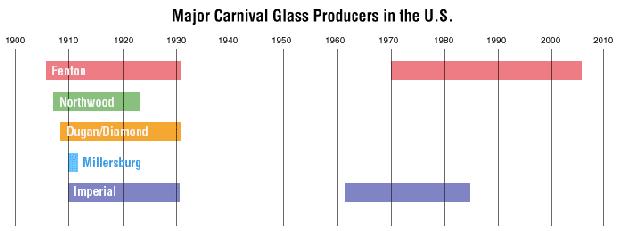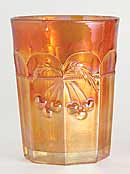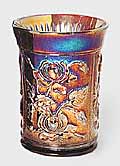National Depression Glass Association
Preserving America's Glass Manufacturing Heritage
A Brief History of Carnival Glass
by David Doty
Carnival Glass was not an instantaneous development in the history of pressed glass. Certainly there were other types of iridized glass, such as art glass. In fact, going back thousands of years, early glass examples have been found to have been iridized by having been buried in ground containing certain chemicals. But the commercial development of pressed glass with an iridized surface was developed in the United States in the early 1900s. The descriptions and history given below are necessarily brief. For more detail, you may want to check the books shown here.

 Among Fenton's first production of Carnival was the Waterlily and Cattails pattern |
Fenton Fenton opened for business in 1905 under the direction of Frank L. Fenton with the help of his brother, John W. Fenton. Frank had worked for several glass manufacturers prior to this. At first the factory decorated glass, then moved on to glass making at it's current site in Williamstown, West Virginia. It's generally accepted that Fenton was the first company to introduce iridized glass, in 1907, which they called "Venetian Art." Some of the earliest patterns in Carnival were Waterlily and Cattails, Vintage, Butterfly and Berries, Peacock Tail, Ribbon Tie, Wreath of Roses, Thistle, and Diamond and Rib vases. In the early 1920s, Fenton introduced one of the most desirable colors in Carnival, red. They also introduced their line of stretch glass late in the '20s. Aside from stretch glass made during the depression, Fenton made no iridized glass between the early 1930s and 1970, when they introduced their "Original Formula Carnival." They continue to reissue some of the original patterns and have purchased some molds from the closed companies. Fenton also has made new molds from which iridized glass is currently being made. |
 Northwood's first Carnival included the Cherry and Cable pattern |
Northwood Northwood began his career working in the glass industry in England. In 1881, he immigrated to the United States and, after working for several glass companies and founding a failed glass company, opened his own company in Indiana, Pennsylvania. He shortly left the company and returned to England. That was brief, too, and he came back to the U.S. and opened H. Northwood in Wheeling, West Virginia, in 1902. In 1908, shortly after Fenton introduced their iridescent line, Northwood introduced theirs, calling it "Golden Iris." This was the ubiquitous color we know as marigold. Northwood's earliest production of iridized glass was in 1908 and included their version of Waterlily and Cattails, Cherry and Cable, and Valentine, among others. About this time they added amethyst, cobalt blue, and green. In 1912, Northwood added the colors we call pastel, ice blue, ice green, and white. But Northwood is probably best known for their aqua opalescent glass, which they added around the same time. Their best known pattern, Grape and Cable, was introduced in 1910. It became so popular that they produced it in many colors and more than 60 differnt shapes. They also are responsible for the best known trademark, the underlined "N" in a circle, which appears on much of Northwood's Carnival, but not all. Harry Northwood died in 1918 and the factory ceased production in the early 1920s. In the 1990's a grandson of Harry's reintroduced the Northwood name, having Fenton make a limited range of pieces. To the best of my knowledge, this venture no longer exists. |
 Dugan's early Carnival included Pinched Swirl. They are also known for their peach opalescent Carnival. |
Dugan Dugan, a cousin of Harry Northwood, also immigrated from England (in 1881). When Harry formed his first glass making company in Indiana, Pennsylvania, Thomas, along with his father and two younger brothers, worked for Harry. Thomas was the plant foreman. When that Northwood venture was purchased by National Glass, Thomas was made factory manager. In 1904, the Dugans purchased the plant, along with some of Harry Northwood's molds, and formed the Dugan Glass Company. In 1913, the Dugans left the company and the name was changed to Diamond. Diamond continued to operate until 1931 when the plant burned down. It's worth noting that until 1981, Carnival collectors were unaware of the Dugan Glass Company. Most thought the Dugan output to be that of Northwood. After the discovery of glass shards at the Indiana, Pennsylvania plant in the 1970s, the late William Heacock uncovered enough additional information to give definitive attribution of many patterns to Dugan. Dugan's Target and Wide Rib vases were the earliest pieces to have the iridescent treatment and were soon followed by such patterns as Quill, Honeycomb, Jeweled Heart, Vineyard, and Pulled Loop vases. This early carnival production was from molds that Dugan already had. They soon added patterns specifically designed for iridescent treatment, such as Farmyard, Christmas Compote, Heavy Iris, and Roundup. Dugan is perhaps best known for the development of the peach opalescent treatment. Opalescent glass, made with bone ash in the mix and reheated to bring out the white opaque, had been around for some time. The Dugans applied the marigold spray, creating an entirely different effect. |
 Millersburg's earliest Carnival included the Hobstar and Feather pattern. |
Millersburg 1908, while still president of Fenton Art Glass, John W. Fenton decided to open his own glass manufacturing facility. He choose Millersburg, Ohio, as the site and purchased several acres of land. The plant was apparently constructed in record time and was state-of-the art for the period. The factory opened in 1909 and began producing crystal glass. John Fenton was more of a promoter than businessman and, while attracting a lot of investor interest, paid little attention to the day-to-day running of the operation. He ordered a huge number of glass molds, but the fledgling operation could not support this expense with subsequent sales and, after one instance of bankruptcy in 1911, finally succumbed in 1912. Although the company produced Carnival Glass for only two short years, the quality was such that it is considered among the best. The first glass that Millersburg iridized, in 1910, was called radium. Collectors still use this name when referring to Carnival that has a bright shiny iridescence. While Millersburg's earliest patterns in Carnival included Hobstar and Feather, Blackberry Wreath, and Rays and Ribbons, it's difficult to be definitive as so many patterns were iridized over so short a period. |
 Among the earliest production in Carnival for Imperial would have been their Rose pattern. |
Imperial 1901, a group of investors organized the Imperial Glass Company in Bellaire, Ohio. When the factory was up and running 1904, Imperial, like other makers, made crystal. When the Carnival fad hit, Imperial, along with Northwood, Dugan, and Millersburg, followed the lead of Fenton. Their production continued until the early 1930's and in the early 1960s, reintroduced their line of iridescent glass. Imperial's famous IG logo was applied to this glass. In 1972, Lenox glass bought the company and added an "L" to the IG mark. In 1981, Aurhur Lorch bought the company and added an "A" to the LIG mark. That venture lasted a year when it was sold again and went out of business a year after that. Imperial is best known for its spectaclar purple Carnival and its smoke Carnival. Smoke is a grayish color on clear glass. The color can actually vary consideraby from a yellowish brown to bluish. Imperial also developed a color called Helios, a silverish iridescence on a light to medium green glass color. |
|
Other makers: While the above makers of Carnival are considered the Big 5, Cambridge, U.S. Glass, Westmoreland, Fostoria, Jenkins, McKee, and Higbee all produced some Carnival. Carnival Glass was also manufactured in other parts of the world, although about 10 years later than in the U.S. It was made in England, Scandinavia, Germany, Czechoslovakia, Australia, Argentina, and Mexico. |
Webmaster's NOTE: This article is being used by permission of the author. His very useful and informative Carnival Glass web site is found at www.ddoty.com, and the references to books on Carnival Glass links directly to his site.